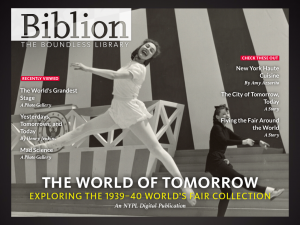Biblion is an iPad application and a compelling digital humanities project created by the New York Public Library. Biblion provides an chance for tablet users to walk through through an extensive archival collection of the 1939-1940 New York World’s Fair without leaving home. The app contains 252 MB of photos, audio, essays and short clips from the Fair, making it one of the largest projects adapted for tablets. If you are an iPad owner and want to make this amazing collection your own, you can do so by visiting http://exhibitions.nypl.org/biblion/worldsfair and tapping on the download button in the upper right corner.
Sources. The period of time between 1939 and 1940 was the turning point for the humanity. The world was in chaos. Humanity was about to enter the most devastating and widespread war of its history. Knowing that the 1939-40 Fair would be the last, the organizers thoroughly recorded the event. All the record was then kept in the New York Public Library for almost a century. Although the collection was available to the public in its physical form, it became truly accessible only after the publishing of Biblion: World’s Fair.
Processes. All the papers were first sorted and processed by their series. The NYPL team then formatted audio and video, turning them into digital files that are compatible with modern media players. All the data is then organized and put into 7 categories: Introduction, A Moment in Time, Enter the World of Tomorrow, Beacon of Idealism, Fashion Food and Famous Faces, From the Stacks, and You Ain’t Seen Nothin’ Yet.
Presentation. The NYPL team did a great job in presenting the collection in an innovative and well ordered way. Once the user clicks on the app icon, the first thing he or she sees are floating groups of images, each labelled with one of the categories mentioned above. In the corner of the screen is a button that opens detailed instructions on how to navigate through the app. Tapping in one of the categories opens an introduction to the category (brief history, what’s in the collection and etc). From there the user can browse through the collection by sliding left and right.
Biblion was made for the general public and, therefore, is relatively simple and straightforward. The NYPL team made sure that the interface was user-friendly. Although it was my first time browsing through a digital collection on my tablet, I had no difficulties whatsoever in navigating through the contents of the app. It is surprising that such a well-made project is available for free, and I encourage everyone to try and take a look at this fascinating collection of the World’s Fair.

The structure for this post is well organized and easy to follow.
I like that you included the background history on why the data from the event was initially recorded.
I like that you included the background history on why the data from the event was initially recorded.
I liked that you included that people can make collections of their own using Biblion. That, in my opinion, is truly in the DH spirit. I may end up downloading it on my iPad. I also thought the 7 categories ( Introduction, A Moment in Time, Enter the World of Tomorrow, Beacon of Idealism, Fashion Food and Famous Faces, From the Stacks, and You Ain’t Seen Nothin’ Yet ) that were decided upon in the processes section were well-representative of the data included, but I also wondered what other ways there were to sort the data.
Nice post Dang. What I really like about the Biblion project is that it makes a solid step towards overcoming the problem of serendipitous discovery that we discussed in class. The sources and images are categorized, but you can visually flip through a lot and stop on ones that grab you by chance, rather than having to search or filter through a bunch of categories to find what you’re already looking for. This is what Stephen Ramsay has dubbed “the hermeneutics of screwing around” and is something that we could stand to have more of in DH projects.
I thought this post was specifically interesting because it pulls together a lot of the media types and DH project types we have discussed. It is an exhibit, but a very interactive one, as well as incorporating audio and video. It’s also interesting that it is specifically created for iPads. Having the ability to touch and move things around adds a whole new dimension to the possibilities of DH projects, but also limit their possible audience.